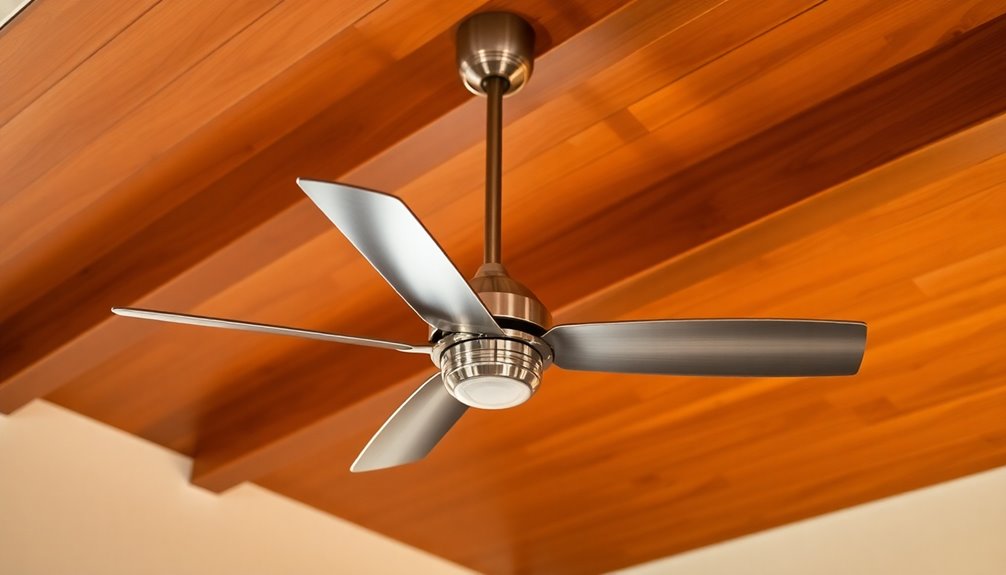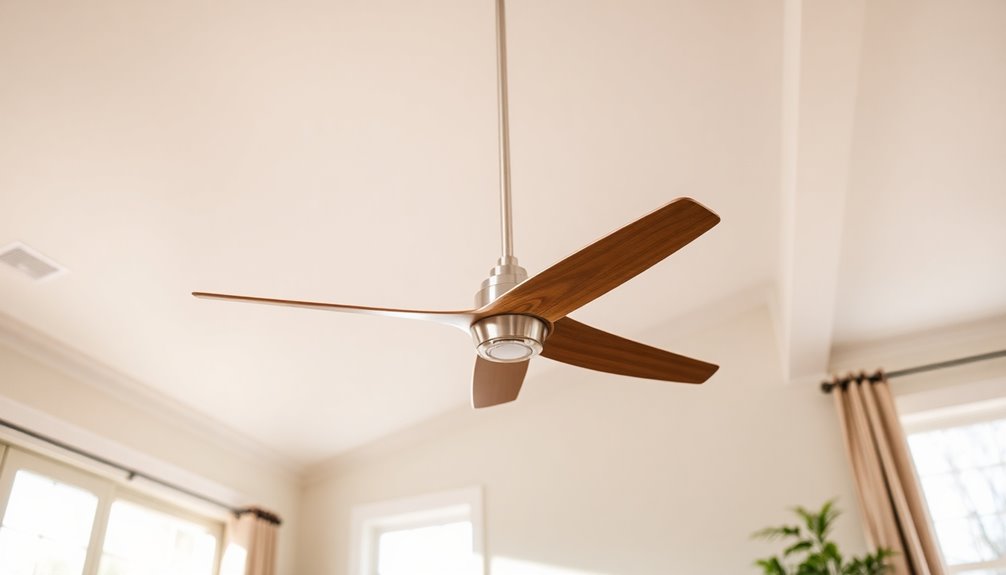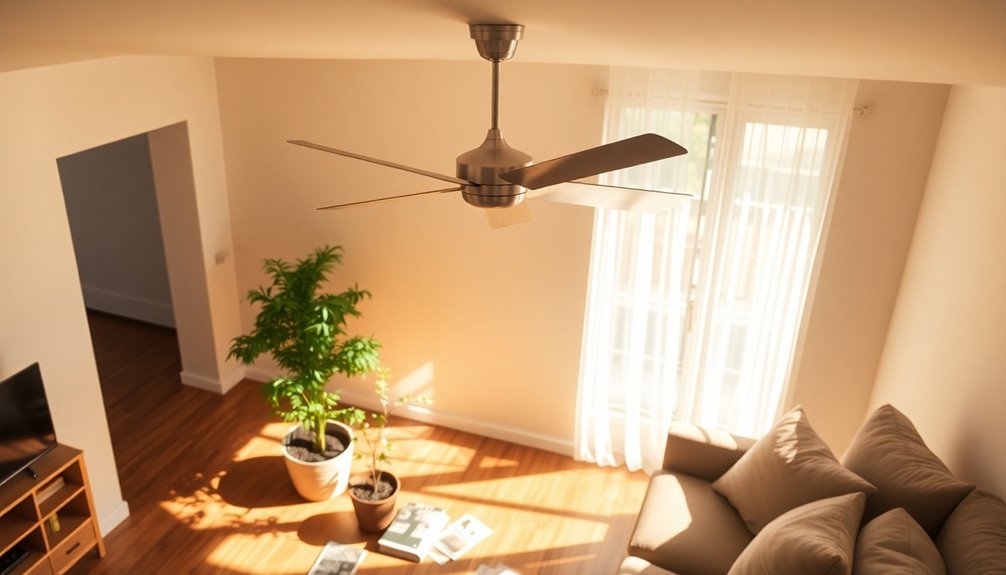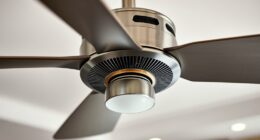A downrod ceiling fan is a type of fan that hangs from the ceiling on a metal rod, making it perfect for high or vaulted ceilings. It enhances airflow by positioning the blades at an ideal height, generally around 8 to 9 feet off the ground. You can find various downrod lengths, usually between 2 to 10 inches, depending on your ceiling's height. Installing the correct size not only improves efficiency but also adds style to your space. If you're looking to maximize comfort and aesthetics in your home, there's more to evaluate beyond just the basics.
Key Takeaways
- A downrod ceiling fan is suspended from the ceiling using a metal rod, ideal for high or vaulted ceilings.
- These fans improve airflow and cooling efficiency by being positioned 8 to 9 feet above the floor.
- Downrods come in various lengths, typically ranging from 2 to 10 inches, for different ceiling heights.
- Proper downrod sizing is crucial for maximizing performance and ensuring safety during operation.
- Downrod ceiling fans are generally quieter than flush mount fans and enhance aesthetic appeal in interiors.
Definition of Downrod Ceiling Fans

A downrod ceiling fan is designed to hang from the ceiling using a metal rod, known as a downrod, which connects the motor housing to the ceiling mount. This configuration allows for ideal positioning and airflow, making it an excellent choice for rooms with high or vaulted ceilings.
You'll find that these fans maintain an ideal height of 8 to 9 feet above the floor, guaranteeing efficient air circulation throughout your space.
Typically, downrod ceiling fans come with standard downrod lengths ranging from 2 to 10 inches. If you have a ceiling that exceeds typical heights, you can consider longer downrods to achieve the desired installation.
It's essential to confirm that the downrod's diameter and threading are compatible with your specific ceiling fan model, as this assures secure installation and stable operation.
Not only do downrod ceiling fans enhance functionality by improving airflow, but they also add aesthetic appeal to a room.
With various styles and finishes available, you can easily find a ceiling fan that matches your interior design while providing the comfort you need.
Importance of Downrod Size

Choosing the right downrod size is essential for maximizing the performance of your ceiling fan. The ideal fan height is between 8 to 9 feet above the floor, which guarantees peak airflow and comfort in your space. If your ceiling height exceeds this range, you'll need to calculate the correct downrod length for efficient air circulation.
Here's a quick reference table to help you visualize downrod lengths based on ceiling heights:
| Ceiling Height | Required Downrod Length | Fan Performance Impact |
|---|---|---|
| 8 feet | 1 inch | Minimal airflow |
| 9 feet | 0 inches | Peak airflow |
| 10 feet | 1 foot | Improved circulation |
| 12 feet | 3 feet | Enhanced comfort |
| 14 feet | 5 feet | Maximum efficiency |
Using an incorrectly sized downrod can lead to inefficient airflow, wobbling, and potential safety hazards. Always verify your downrod matches your ceiling height and fan model for the best results. Remember, compatibility is key to achieving that perfect balance of style and functionality in your home.
Measuring for Downrod Length

When it comes to measuring for downrod length, getting it right from the start can save you time and hassle later on. To determine the appropriate downrod length, first measure the height of the ceiling. Subtract 9 feet from this measurement, as the ideal height for a ceiling fan is 8 to 9 feet above the floor.
For example, if your ceiling is 12 feet high, you'll need a 3-foot downrod to achieve the best ceiling fan height.
Make sure you use a tape measure to accurately measure your ceiling height, avoiding any incorrect sizing of the downrod. Don't forget to account for the height of the fan itself, as this will impact the distance from the floor to the fan blades.
Additionally, if you have vaulted or sloped ceilings, you may need longer downrods for proper installation.
- The perfect airflow can transform your space.
- Avoid the frustration of a poorly installed fan.
- Enjoy the comfort of a well-measured, stylish fan.
Benefits of Downrod Ceiling Fans

Downrod ceiling fans offer significant advantages that can elevate your comfort and style at home. One of the key benefits is optimized air circulation. By hanging the fan at an appropriate height, you guarantee that it effectively cools high or vaulted rooms, providing a revitalizing breeze where it's needed most.
This improved airflow can lead to a reduced reliance on air conditioning, translating into energy savings of up to 30% during warmer months.
Safety is another vital aspect. With a minimum clearance of 7 feet from the floor, downrod fans prevent potential hazards associated with low-hanging fixtures, making your space safer for everyone.
Plus, they come in various lengths and finishes, allowing you to choose a design that complements your interior style seamlessly.
Noise is often a concern with ceiling fans, but downrod models typically operate more quietly than flush mount fans. This means you can enjoy a cool, comfortable environment without the distracting whir of machinery.
Installation Considerations

Installing a downrod ceiling fan requires thoughtful planning to guarantee it operates effectively and safely. First, measure your ceiling height accurately. This guarantees your fan's positioned correctly for ideal airflow and safety. You'll want to maintain a clearance of about 10 inches from the ceiling and at least 7 feet from the floor to the ceiling fan blades for best performance.
Consider these key points during installation:
- Maximize airflow by placing the fan at the right height.
- Confirm safety by avoiding risky DIY installations, especially on high ceilings.
- Check compatibility with your fan model to prevent installation headaches.
If your ceilings are particularly high or vaulted, opting for a longer downrod may be necessary.
Always keep in mind that proper installation might require professional assistance to secure all components adequately. This way, you can relax knowing your ceiling fan will function smoothly and safely, enhancing your living space.
Taking these considerations into account will help you enjoy all the benefits that a downrod ceiling fan has to offer.
Frequently Asked Questions
Why Use a Downrod on a Ceiling Fan?
Using a downrod on your ceiling fan is essential for maximizing airflow and efficiency, especially in rooms with high ceilings.
It positions the fan blades at the ideal height, so you get better circulation. Plus, it stabilizes the fan, reducing wobbling during operation.
You can choose the downrod's length based on your ceiling height, ensuring a customized fit while also enhancing your room's aesthetics with various finishes and styles.
Can a Ceiling Fan Be Installed Without a Downrod?
Installing a ceiling fan is like hanging a painting—sometimes it needs space to shine.
Yes, you can install a ceiling fan without a downrod if it's a flush mount designed for low ceilings. These fans sit snug against the ceiling, perfect for rooms with heights under 8 feet.
For standard ceilings, you mightn't need one either, but for higher spaces, a downrod helps optimize airflow and keeps your fan from feeling cramped.
What Is the Difference Between Ceiling Mount and Downrod Mount Fans?
When choosing between ceiling mount and downrod mount fans, you'll notice key differences.
Ceiling mount fans sit directly against the ceiling, making them perfect for standard heights.
In contrast, downrod mount fans hang lower, accommodating high or vaulted ceilings and improving airflow.
You'll also find that downrod fans offer more stability and design options, enhancing both performance and aesthetics in larger spaces compared to the flush-mounted alternatives.
Do I Need an Extension Rod for a Ceiling Fan?
They say, "A fan's worth is in the breeze it creates."
If your ceiling's high, you might need an extension rod for your ceiling fan. Measure your ceiling height and subtract the fan's height; if it's less than 7 feet, you'll need that downrod to achieve the best airflow.
Installing the fan too high can lead to inefficient cooling, so make sure you choose the right length for your specific setup.
Conclusion
To summarize, downrod ceiling fans are a stylish and effective way to improve airflow in your space. Did you know that using a downrod can increase your fan's efficiency by up to 30%? By choosing the right downrod length, you not only enhance comfort but also save on energy costs. So, whether you're cooling down a room or adding a decorative touch, a downrod ceiling fan is definitely worth considering for your home.









